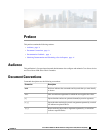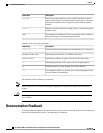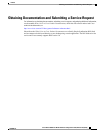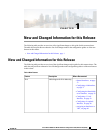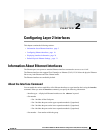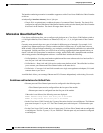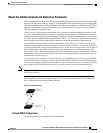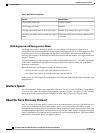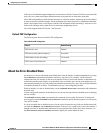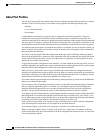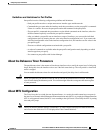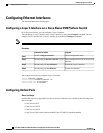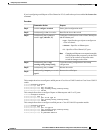
The interface numbering convention is extended to support use with a Cisco Nexus 2000 Series Fabric Extender
as follows:
switch(config)# interface ethernet [chassis/]slot/port
• Chassis ID is an optional entry to address the ports of a connected Fabric Extender. The chassis ID is
configured on a physical Ethernet or EtherChannel interface on the switch to identify the Fabric Extender
discovered via the interface. The chassis ID ranges from 100 to 199.
Information About Unified Ports
Cisco Nexus unified ports allow you to configure a physical port on a Cisco Nexus 5500 Platform switch as
a 1/10-Gigabit Ethernet, Fibre Channel over Ethernet (FCoE), or 1-, 2-, 4-, 8-Gigabit native Fibre Channel
port.
Currently, most networks have two types of switches for different types of networks. For example, LAN
switches carry Ethernet traffic up to Catalyst switches and SAN switches carry FC traffic from servers to
MDS switches. With unified port technology, you can deploy a unified platform, unified device, and unified
wire approach. Unified ports allow you to move from an existing segregated platform approach where you
choose LAN and SAN port options to transition to a single, unified fabric that is transparent and consistent
with existing practices and management software. A unified fabric includes the following:
• Unified platform—Uses the same hardware platform and the same software code level and certifies it
once for your LAN and SAN environments.
• Unified device—Runs LAN and SAN services on the same platform switch. The unified device allows
you to connect your Ethernet and Fibre Channel cables to the same device.
• Unified wire—Converges LAN and SAN networks on a single converged network adapter (CNA) and
connects them to your server.
A unified fabric allows you to manage Ethernet and FCoE features independently with existing Cisco tools.
Guidelines and Limitations for Unified Ports
• Ethernet ports and Fibre Channel ports must be configured in the following order:
• Fibre Channel ports must be configured from the last port of the module.
• Ethernet ports must be configured from the first port of the module.
If the order is not followed, the following errors are displayed:
ERROR: Ethernet range starts from first port of the module
ERROR: FC range should end on last port of the module
• On the Cisco Nexus 5548UP switch, the 32 ports of the main slot (slot1) are unified ports. The Ethernet
ports start from port 1/1 to port 1/32. The Fibre Channel ports start from port 1/32 backwards to port
1/1.
• For the Cisco Nexus 5596T switch, the last 16 ports (ports 33-48) are Fiber Channel and are configurable
as unified ports. The first 32 ports (1-32) are 10GBase-T Ethernet ports only and cannot be configured
as unified ports.
Cisco Nexus 5000 Series NX-OS Interfaces Configuration Guide, Release 5.2(1)N1(1)
4 78-26881-OL
Configuring Layer 2 Interfaces
Information About Unified Ports




